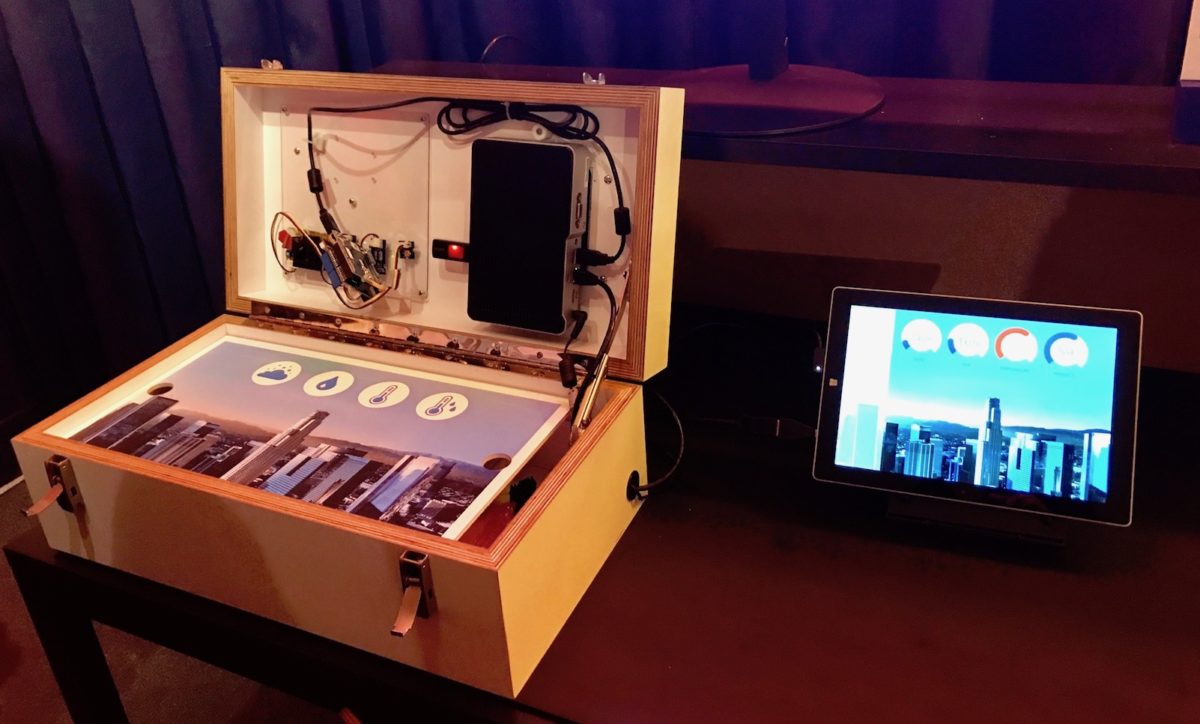Over the past year, New Lab has become a prime destination for local hardware-focused startups. Among the main attractions: its labs and specialized equipment for materials ranging from wood and metal to advanced electronics.
Now the workspace is adding software resources to build upon its already-impressive array of prototyping tools. New Lab unveiled Tuesday an “innovation workshop” sponsored by Intel and Lenovo, which features products from both companies. The launch event included demos of Intel’s drone, virtual-reality and internet-of-things technologies, all of which are showcased within the new branded space. According to spokesperson Molly Erman, the workshop is part of a new initiative to forge partnerships with larger tech companies in order to support New Lab’s members. (Editor’s note: In that respect, it’s similar to Philadelphia’s Pennovation Center, which has lured an outpost of the world’s biggest drone maker, DJI, as well as not-too-techy corporations like Hershey.)
The additional resources may aid companies that work intensely in both hardware and software development. For instance, BlocPower, which runs a platform for residents and landlords to identify ways to improve their buildings’ energy efficiency, is a member of the Hub @ GCT, the city’s software-focused tech accelerator for “smart cities” companies. (Its hardware-focused counterpart, the Urban Tech Hub, is based in New Lab.) But the company keeps a few seats at New Lab, where employees work on development of the sensors the company uses to collect energy-efficiency readings.
BlocPower was one of a few companies we’ve previously covered that were present at Tuesday’s launch event. Its products and services were on display alongside the new offerings from Intel and Lenovo. Here’s a glimpse of what we saw.
BlocPower’s heat map of Brooklyn highlights buildings that aren’t very energy efficient.

Neda Arabshahi, BlocPower’s chief operating officer, walked us through the company’s analytics platform, which includes a heat map of all the buildings in New York City and their estimated energy efficiency ratings. The platform uses machine learning to provide those estimates based upon the building’s age, number of floors and usage (for instance, whether it’s a residential building or a church).
The company is also launching a loan fund to provide financing for building upgrades in low-income communities (which CEO Donnel Baird mentioned when we last spoke with him). Its initial focus is the Bronx, which has one of the highest asthma rates among youth in the U.S. “We’re targeting the buildings sending the most kids to the hospital with asthma attacks,” Arabshahi said.
Farmshelf’s hydroponic system will soon be in Greenpoint’s Norman restaurant.

If you’ve ever visited New Lab, Farmshelf’s office full of greenery has probably caught your eye. The startup is now selling its hydroponic growing systems to restaurants, including the Great Northern Food Hall in Grand Central Terminal, run by star chef Claus Meyer.
Later this month, a Farmshelf system will be coming to another Meyer-affiliated restaurant, Norman, which is located within the Greenpoint design makerspace A/D/O. The Farmshelf systems are designed to be attractive enough to house in a restaurant’s main space. The company’s next step, CEO Andrew Shearer said, is to improve upon its system so that it requires minimal attention from already-harried chefs. “Our goal is to make something that can truly be called an automated system,” he said.
An attendee tries out Intel’s VR platform, which shows baseball games in 3D.

Want to launch your own drone? You can see the tech firsthand at New Lab.

Intel also had some eye-catching products on display.
Drones made a notable appearance: two were prominently on display near the entrance of the innovation workspace, along with the packaging for the company’s aerial development platform. Company representatives also demoed Intel’s VR platform, in which sports games are rendered in 3D. We tested out the system, and from our perspective, it succeeded in providing a close-up view of the game from behind home plate. The rep we spoke with suggested that soon enough, the average fan will be watching sports this way. While we’re a bit skeptical of that prediction, the demo showed that it is at least a possibility.
Keemotion’s camera system automatically adjusts the frame to capture the action of a basketball game.

Keemotion originally got started in Belgium, but since March, it has called New Lab home. (Its CEO, Milton Lee, has a personal connection to the borough, having come to the company from the Brooklyn Nets.) The company makes a camera system for sports events that tracks the motion of athletes, so that the frame automatically adjusts to capture the action on the court or field.
In other words: no cameraman needed.
Keemotion has worked with six NBA teams, including the Golden State Warriors, as well as ESPN and Fox Sports 1, chief operating officer Alexandre Bustamante told us. Earlier this year, the company’s product made the shortlist for the Cannes Lions Innovation awards.
Peter Noh, StrongArm Technologies’ visual design director, models the company’s sensor system.

StrongArm Technologies, which develops ergonomic systems for workers, was one of New Lab’s original members. The company has gained some renown for its FLX “ergoskeleton,” which is used to train workers in proper posture for task such as lifting boxes and loading equipment. Its latest product, which visual design director Peter Noh modeled, is Fuse, a sensor system that tracks each worker’s exposure to risk factors such as muscle strain. A software dashboard enables companies to track the data collected from each sensor and identify ways to lower the risk of injury to workers.
Interestingly enough, StrongArm refers to the workers its products are designed to help as “industrial athletes.” It’s something we noticed while taking a look at the dashboard. Noh told us that’s a deliberate choice to reflect the philosophy behind StrongArm’s products. “They’re using physical ability and skill, just like an athlete,” he said.







